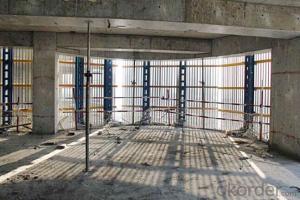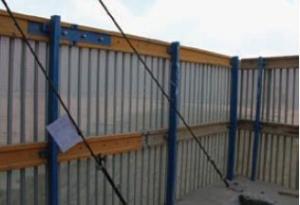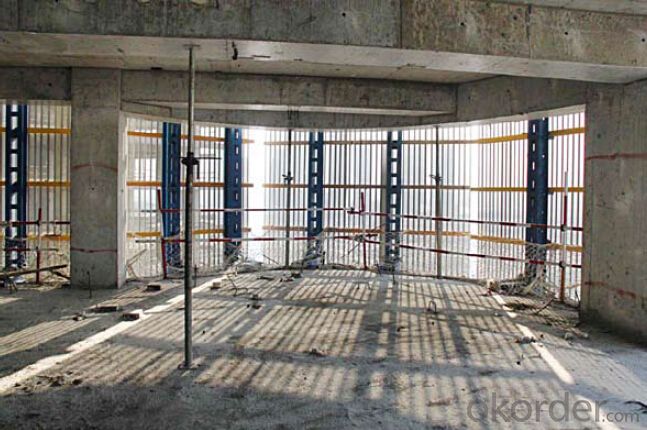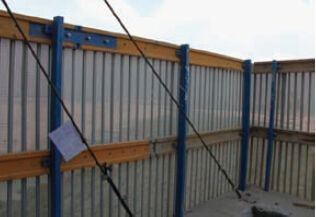Protection Platform for Formwork and scaffolding systems
- Loading Port:
- Tianjin
- Payment Terms:
- TT OR LC
- Min Order Qty:
- 50 m²
- Supply Capability:
- 1000 m²/month
OKorder Service Pledge
OKorder Financial Service
You Might Also Like
Protection Platform PP-50
A kind of new type construction protection system, applying operating platform and safer job
location for construction corps.
Characteristics:
◆ Easy and quick assembling.
◆ Lifted as a group, it is rapid and economic.
◆ Auto-climbing
◆ A safe and reliable anchor system
1. Composition
2. Assembly process of anchor system
(1) Embed V-climbing cone and anchor plate into the slab.
(2) Fix anchor shoe on the slab by tensile bolt.
(3) The fixed anchor shoe.
◆ High work efficiency with work platform and unload platform
◆ High light transmittance with the hollow block
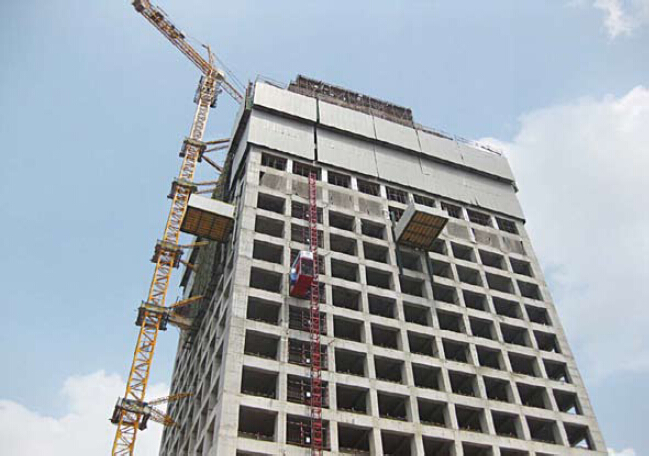
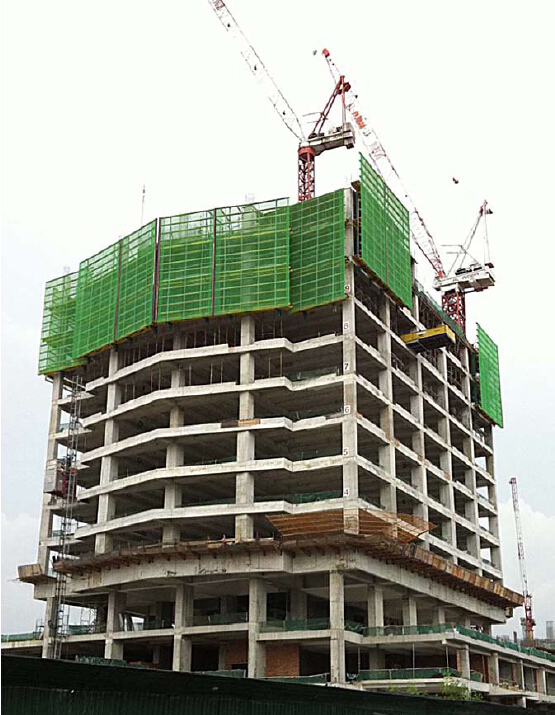
- Q: What are the common design considerations for steel formwork?
- To ensure the efficiency and effectiveness of steel formwork design, several factors must be taken into account. Firstly, the load-bearing capacity of the formwork needs careful calculation and design to support the weight of fresh concrete and any additional loads without deformation or failure. This involves evaluating maximum expected load and selecting the appropriate steel grade and thickness. Secondly, the formwork should be easily assembled and disassembled, which is crucial for projects with tight schedules or limited space. Modular components that can be quickly and accurately connected should be used, allowing for efficient construction and easy removal after the concrete cures. Thirdly, the desired surface finish of the concrete should be considered in the formwork design. Proper alignment and leveling are necessary for a smooth and consistent finish. Additionally, the formwork should be designed to prevent leakage or seepage, which could cause imperfections or structural issues. Stability and rigidity are also important considerations. The formwork must withstand lateral pressure from the fresh concrete without significant deformation or displacement. Proper bracing and tie systems should be incorporated for stability during the pouring process. Safety should be prioritized in the formwork design, providing a safe working environment with adequate access, guardrails, and fall protection systems. Installation and removal of safety features should also be considered. Lastly, the reusability and durability of the steel components should be taken into account. The formwork should be designed to withstand repeated use and resist corrosion or wear. Maintenance and storage considerations are also important for prolonging the lifespan of the formwork. In conclusion, the design of steel formwork should consider load-bearing capacity, ease of assembly and disassembly, surface finish requirements, stability and rigidity, safety, reusability, and durability. By carefully considering these factors, well-designed steel formwork can contribute to the successful and efficient construction of concrete structures.
- Q: Can steel formwork be used for both small and large-scale concrete placements?
- Steel formwork is versatile and can be employed for concrete placements of any size. With its robustness and endurance, steel formwork is ideal for a range of construction endeavors. Its assembly and disassembly are effortless, enabling cost-effective utilization in both minor and major concrete placements. Moreover, steel formwork imparts a uniform and sleek finish to the concrete surface, guaranteeing superior outcomes irrespective of the project's magnitude. Consequently, be it a petite residential construction or an expansive infrastructure venture, steel formwork proves to be a dependable option for concrete placements.
- Q: Can steel formwork be used in precast concrete applications?
- Precast concrete applications can indeed utilize steel formwork. Steel, being a versatile and durable material, can withstand the pressures and forces exerted throughout the precasting process. It offers exceptional support and stability during pouring and curing, aiding in the creation of precise shapes and detailed concrete elements. This results in accurate dimensions and a top-notch finish. Moreover, steel formwork can be swiftly assembled and disassembled, making it ideal for fast-paced and repetitive precast production. Overall, due to its strength, versatility, and ease of use, steel formwork is extensively employed in precast concrete applications.
- Q: Can steel formwork be used for residential construction projects?
- Residential construction projects can indeed utilize steel formwork. This option, known for its versatility and durability, presents several advantages in the realm of residential construction. It furnishes a solid and steady framework for the pouring of concrete, guaranteeing accurate and uniform shapes for walls, slabs, and other structural elements. Steel formwork proves to be highly reusable, rendering it an economical selection for residential endeavors with multiple concrete pours. It endures numerous uses and can be effortlessly assembled and disassembled, thereby expediting the construction process and reducing labor costs. Furthermore, steel formwork delivers exceptional dimensional stability, ensuring the final structure possesses precise dimensions and smooth finishes. It can withstand the pressure exerted by wet concrete, enabling the construction of high-rise buildings or structures bearing heavy loads. Moreover, steel formwork permits design flexibility, granting architects and builders the ability to fashion unique and intricate shapes within residential edifices. This adaptability renders it suitable for a diverse array of architectural styles and designs. While the initial investment for steel formwork may be higher compared to other formwork materials, its prolonged lifespan and reusability make it an economically viable solution in the long term. It also demands less maintenance and repair when contrasted with traditional timber formwork. In conclusion, steel formwork represents a fitting option for residential construction projects due to its strength, durability, reusability, dimensional stability, and design flexibility. It bestows numerous benefits and aids in the successful completion of top-quality residential structures.
- Q: How does steel formwork handle concrete curing additives?
- Steel formwork is a popular choice for concrete construction due to its durability and strength. When it comes to handling concrete curing additives, steel formwork is highly compatible and can effectively accommodate the use of such additives. Concrete curing additives, such as accelerators or retarders, are used to modify the setting and hardening time of concrete. These additives are typically added to the concrete mixture during the mixing process or applied to the surface of the formwork before pouring the concrete. Steel formwork is not adversely affected by the presence of curing additives in the concrete. It is resistant to chemical reactions and can withstand the potentially corrosive nature of certain additives. This ensures that the steel formwork remains structurally sound and maintains its integrity throughout the concrete curing process. Furthermore, steel formwork offers a smooth and non-porous surface, which allows for easy application and penetration of curing additives. This facilitates the even distribution of additives across the concrete surface, promoting consistent curing and optimal strength development. Moreover, steel formwork is reusable, which means that it can be used for multiple concrete pours. This reusability factor is particularly advantageous when working with concrete curing additives, as the formwork can be easily cleaned after each use, ensuring that no residue or build-up of additives remains on the surface. This helps to prevent any potential interference with subsequent concrete pours or compromising the quality of the cured concrete. In summary, steel formwork is well-suited for handling concrete curing additives. Its chemical resistance, smooth surface, and reusability make it an ideal choice for accommodating the use of curing additives, ensuring efficient and effective concrete curing.
- Q: How does steel formwork handle different concrete curing temperatures?
- Steel formwork is an incredibly durable and flexible construction material that is ideal for managing various concrete curing temperatures. Its main advantage lies in its ability to endure high temperatures without warping or causing structural damage. The concrete curing temperature can differ based on numerous factors, such as the weather, project requirements, and construction timetable. Steel formwork is specifically designed to withstand these differences and maintain its structural integrity throughout the curing process. When the concrete curing temperature is high, steel formwork effectively disperses the heat thanks to its exceptional thermal conductivity. This prevents excessive heat accumulation, which could lead to premature curing or thermal cracking of the concrete. The steel formwork acts as a heat absorber, evenly absorbing and distributing the heat to ensure consistent curing throughout the concrete structure. On the other hand, steel formwork also performs well in low-temperature curing conditions. Its high tensile strength and rigidity allow it to withstand the pressure exerted by the cold concrete mixture during curing. This prevents any distortion or warping of the formwork, ensuring precise shaping of the concrete structure. Furthermore, steel formwork is resistant to moisture and humidity, which are crucial factors in concrete curing. It does not absorb water or release moisture, maintaining a steady moisture content in the concrete during the curing process. This is particularly advantageous in areas with high humidity or when the curing time is prolonged. In conclusion, steel formwork is a dependable and sturdy material that can effectively handle various concrete curing temperatures. Its ability to disperse heat, endure cold temperatures, and resist moisture makes it the preferred choice for construction projects where temperature variations are a concern.
- Q: Can steel formwork be used in hygienic or sterile environments?
- When using steel formwork in hygienic or sterile environments, it is important to take precautions to maintain cleanliness and sterility. Steel formwork is a strong and durable choice for construction and is commonly used in hospitals, laboratories, and food processing facilities. However, it is important to note that steel is not naturally sterile and can harbor bacteria or contaminants if not properly maintained. To ensure the suitability of steel formwork in hygienic or sterile environments, several measures can be taken. Firstly, the formwork should be thoroughly cleaned and sanitized before use. This involves using approved cleaning agents and following specific protocols to remove dirt, debris, and potential contaminants. Furthermore, a protective coating or finish can be applied to the steel formwork to create a smooth and non-porous surface that is easier to clean and disinfect. This helps prevent the accumulation of bacteria or microorganisms on the formwork. Regular maintenance and inspections are also crucial to maintain the hygienic condition of the steel formwork. Any signs of wear, damage, or corrosion should be promptly addressed and repaired to prevent the formation of cracks or crevices where bacteria can grow. It is important to note that in extremely sensitive sterile environments, materials such as stainless steel or specialized plastics may be preferred over traditional steel formwork. These materials have properties that make them more resistant to corrosion, easier to clean, and compatible with strict hygiene or sterilization protocols. Ultimately, the suitability of steel formwork in hygienic or sterile environments depends on the specific requirements and regulations of the environment. Proper cleaning, maintenance, and adherence to hygiene protocols are essential to ensure that steel formwork can be used effectively without compromising cleanliness or sterility.
- Q: Can steel formwork be used for projects with complex geometries?
- Indeed, projects with intricate geometries can make use of steel formwork. Thanks to its high strength and durability, steel formwork proves to be suitable for managing complex shapes and intricate designs. The fabrication and customization of steel formwork can be easily achieved to meet the project's specific requirements, enabling the creation of complex geometries while maintaining structural integrity. Furthermore, steel formwork guarantees exceptional dimensional stability, ensuring the precise and accurate construction of complex shapes. Given its versatility and flexibility, steel formwork emerges as the preferred option for projects involving intricate and complex geometries.
- Q: How does steel formwork affect the overall productivity of the construction process?
- Steel formwork can have a significant impact on the overall productivity of the construction process. Firstly, steel formwork is known for its durability and strength, allowing it to withstand the high pressures and forces exerted by concrete during the pouring and curing stages. This durability ensures that the formwork remains intact and stable, reducing the need for repairs or replacements, thus saving time and cost. Moreover, steel formwork offers increased efficiency in terms of assembly and disassembly. Steel panels can be easily connected and detached, allowing for quick and smooth installation and removal. This ease of use ensures that the construction process can progress at a faster pace, increasing overall productivity. Additionally, steel formwork provides a smooth and high-quality finish to concrete structures. The precise and rigid nature of steel formwork prevents any deformations or warping during the pouring and curing stages, resulting in a superior surface finish. This eliminates the need for additional finishing work, such as plastering or smoothing, thereby reducing the time and effort required for post-construction tasks. Furthermore, steel formwork is highly adaptable and can be customized to fit various shapes and sizes, enabling the construction of complex structures with ease. This flexibility allows for greater design freedom and eliminates the need for additional supporting structures, reducing construction time and increasing productivity. Lastly, steel formwork is reusable and can be used for multiple projects, unlike traditional timber formwork which often needs to be discarded after a single use. This reusability not only reduces material waste but also saves time and cost in procuring new formwork for each project. In conclusion, steel formwork significantly enhances the overall productivity of the construction process. Its durability, ease of assembly, high-quality finish, adaptability, and reusability all contribute to faster construction timelines, reduced costs, and improved efficiency, making it a preferred choice for many construction projects.
- Q: Can steel formwork be used for staircase construction?
- Indeed, steel formwork is perfectly suitable for the construction of staircases. This versatile and resilient material is frequently employed in construction ventures, including staircase construction. It furnishes a robust and secure framework for pouring concrete and guarantees the meticulous and precise formation of the staircase. Moreover, steel formwork can be reused, rendering it a cost-effective option for repetitive construction procedures such as staircase construction. Furthermore, it offers adaptability in terms of design, enabling the creation of diverse staircase shapes and dimensions. In summary, steel formwork is an ideal selection for staircase construction due to its potency, durability, reusability, and design flexibility.
Send your message to us
Protection Platform for Formwork and scaffolding systems
- Loading Port:
- Tianjin
- Payment Terms:
- TT OR LC
- Min Order Qty:
- 50 m²
- Supply Capability:
- 1000 m²/month
OKorder Service Pledge
OKorder Financial Service
Similar products
Hot products
Hot Searches
Related keywords
